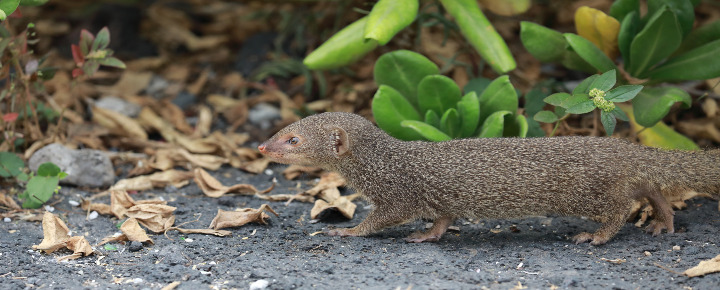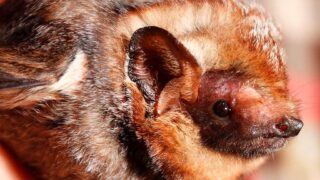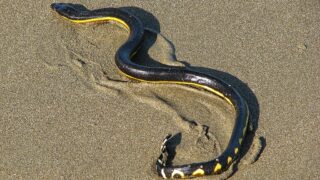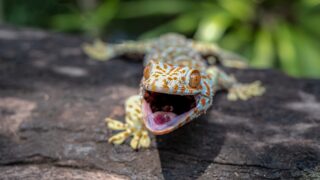Mongooses in Hawaii are a big problem and even more so on Kauai which has been relatively free of them. The small Indian mongoose is native to Asia and was intentionally brought to other places including the Caribbean and Hawaii.
These animals which look like a weasel and are about 2 feet in length, low to the ground, and with a long tail, are considered opportunistic feeders. They sleep in dens at night and are active during daylight hours. We’ve seen them frequently on the Big Island.
Impacts of Mongoose invasive species throughout most of Hawaii.
The small mongooses eat birds and their eggs, in addition to other small animals, plants, fruits, and insects. The problem here is that they prey on the endangered Hawaiian sea turtles and native ground-nesting birds. They are already implicated in the deaths of 8 species of federally endangered Hawaiian birds, including the Hawaiian crow, petrels, and the Hawaii state bird (Nene).
Kauai has been largely free of mongooses up until now and we hope that continues to be the case.
Another mongoose was found this week on Kauai.
A mongoose was trapped this week for the first time in five years. It was captured at the Nawiliwili boat harbor after being spotted by state workers and subsequently reported to the Department of Agriculture. 15 traps were set Monday and the animal was caught on Tuesday. The state plans to keep the traps in place to determine if other mongooses are present.
Mongooses in Hawaii: brought to sugar plantations to control rat populations.
The mongooses here were imported from Asia via Jamaica in the late 1800s by individuals in the sugarcane industry, initially to the Hamakua Coast on the Big Island, in the false belief that they would control the rat problem in the cane fields on Molokai, Maui, and Oahu.
The introduction to Hawaii Island was not done scientifically based on research and was instead an ad-hoc, misguided effort. While they may have eaten some rats, they didn’t control the rodents and instead had a highly deleterious impact on important birds, insects, and other animals. Mongoose became rampant on the Big Island in addition to the other three islands where they were introduced.
One serious mistake was that rats are nocturnal whereas mongooses are diurnal. Therein the two populations are not typically active at the same time.
Keeping a mongoose is subject to a $1,000 fine per mammal, other than by permit.
No known mongoose populations exist on Kauai or on Lanai.
In 1976, a female mongoose was found dead on rural Kauai. Sightings have been reported elsewhere, and in 2012, a live one was captured near the airport. followed by another at Nawiliwili Harbor. Until this latest incident, the last one captured was in 2016, which was also near the airport. The state is still trying to determine whether any population of animals exists.
Folklore had it that when mongooses bound for Kauai arrived in the late 1800s, a dock worker handling them was bitten. He allegedly threw the container of animals into the water, killing them.
Don’t mistake a cat or a rat for a mongoose. Look for the short legs.
Keep in mind that mongooses are largely only active during the day while cats are active at night. Also, the mongoose has a brownish body, a long head with a pointed nose, and holds its tail level with the ground, whereas cats typically hold their tails at angles. Rats, another invasive species that was introduced to Hawaii are much smaller than mongooses and are again largely nocturnal.
Get Breaking Hawaii Travel News







Shouldn’t the plural of mongoose be “mongeese”?
I’ve spotted two in Maui in three days. Usually species are introduced by people who either fail to understand the possible long term impact or simply ignore the negative implications. Usually because of profit related reasons. In the eastern US, this was done with the coyote. The story is that the auto insurance industry was behind it, in order to reduce deer populations from cars hitting them. Unfortunately, coyotes mainly prey on small game and have decimated the red fox. And they are there to stay. Hunters can’t control them.
Trappers are not enough because fur prices are next to nothing. Im afraid your mongoose problem is likely here to stay, short of putting a worthwhile bounty on them and then dealing with anti-hunting groups.
These look like what’s running around the Marriott property in Oahu Ko Olina
Always see at least one mongoose at the Marriott Resort on Oahu on out annual trip to Hawaii.
I was a bit surprised that BOH didn’t share the history of why Kauai escaped the importation. It’s a fascinating tale that I will leave to the editors at BOH to decide if it’s worth an edit.
Hi James.
Done. Thank you.
Aloha.
Hi, I would love to hear the story. We live here and our kids heard from an Uncle a story and were wanting to research it for a school report but we can’t find anything?
The important thing was this mongoose vaccinated and/or adhering to Kauai covid protocols? I kid. This is one of those things that make front page news on Kauai but visitors or part time condo owners just don’t get why this is so important and a news item. Mahalo guys, once again, for showing life on the islands the way it is for locals.
Hi Kauaidoug.
LOL. Thanks. Yes, we sure hope those don’t get established here. Our native bird population is already beyond fragile.
Aloha.
The mongoose, aka, the Hawaiian speed bump.
We may not have them on Kauai, but we make up for it in cane toads.
And chickens.